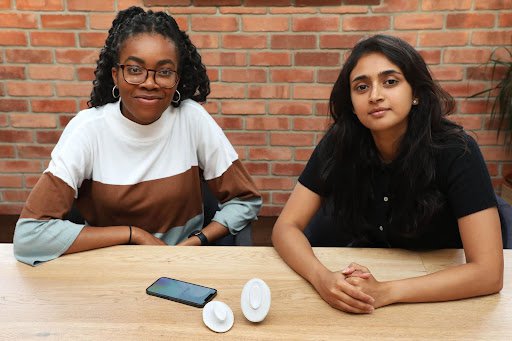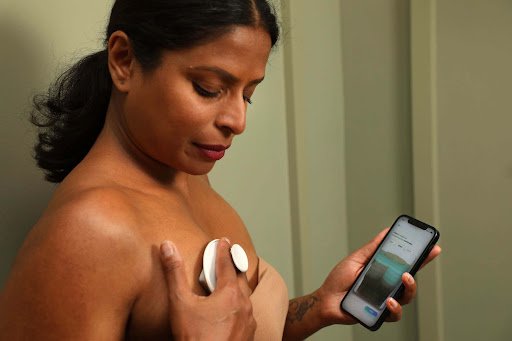A New Tool Could Help Detect Breast Cancer Earlier
Dotplot gives users real-time feedback and builds a personalized map of their chests

Shefali Bohra was working out at the gym one day when she felt an uncomfortable knot in one of her breasts. Concerned, she went to her gynecologist, who performed a palpation test. The doctor told her to monitor the lump herself for a few months and see if she still felt any discomfort.
“Fortunately, there wasn’t anything to be concerned about,” Bohra says. The knot resolved itself. But the experience still stuck with her.
A few years later, when Bohra was completing her master’s degree in innovation design engineering at the Royal College of Art and Imperial College London, she met Debra Babalola, who was in the same program. The students were tasked with creating something impactful to drive change, and both were interested in health care. Bohra thought back to the lump, and she wondered if a better method existed to monitor breast health at home.
The pair found that when it comes to self-exams, resources are limited to mostly pamphlets and videos.
“None of them really resolve the confusion that people experienced with doing their self-checks,” Babalola says. “That’s why we wanted to create something that would guide you through the process and just make the checking as easy as possible.”
Together, the two created Dotplot, a handheld device and app that map a user’s chest and take readings of their breast tissue using sound waves.
Before designing their device, Bohra and Babalola conducted interviews with 50 women of varying ages and backgrounds, and they gathered information about how these women were performing self-checks. They presented the group with different physical and digital prototypes of a breast monitoring tool to determine an ideal design. From these conversations, they found that the women wanted a handheld device, rather than something wearable, that provided visual guidance and feedback.
“People said that they tended to trust the interaction when they were actually holding the device and checking themselves with it,” Babalola says. “And it also made them just feel like they’re all part of the process, which is good.”
The device is oval-shaped and slightly smaller than a computer mouse, with a gripper on one side so users can hold it in one hand. It has an on-off switch on the side and uses a stand to recharge.
To get started with the device, users input information into the app, including breast size and shape, the date of their last period and if they’re pregnant or doing hormone replacement therapy. Then, they rescale the baseline model by sliding the handheld device from their collarbone to their left nipple, from their left to right nipple and finally to the right collarbone.
“After that, you can do your first scan,” Bohra says. “The read is divided into three different regions. Region one is the top. Region two is the breast area. And region three is basically the area between the breast and the end of the ribcage.”
The app provides a step-by-step guide to users, showing them exactly where they need to move the device to ensure the entire chest is checked. After the first read is complete, the app creates a region-specific report that it compares to future monthly reports. The user can also manually view their report, which includes a pixelated image of their torso. Users will be able to choose to send a report directly to their doctor.

Babalola explains that while the device doesn’t use ultrasound technology, it works similarly, emitting sound waves of a known frequency that travel through a user’s breast. The sound waves can record the composition of the tissue, echoing back differently when they hit a tumor versus fatty tissue.
In the United States, women face a one in eight chance of developing breast cancer at some point in their lives. It accounts for about 30 percent of all new cancer cases in women each year. Spotting breast cancer early is key for treating it successfully; the five-year survival rate for those diagnosed with invasive cancer only found in the breast is 99 percent. That number drops to 26 percent once it has spread to distant parts of the body, though this only represents 6 percent of cases.
The usefulness of monthly breast self-exams, which doctors had promoted for more than 30 years, has recently been a matter of debate within the medical community. Several major organizations, including the American Cancer Society, the U.S. Preventive Services Task Force (USPSTF) and Cancer Research U.K., no longer recommend the practice, citing large studies that suggest these monthly checks don’t decrease deaths from breast cancer. Instead, women who do them are almost twice as likely to have an unnecessary biopsy, according to Cancer Research U.K.
But Brian Wojciechowski, a medical oncologist with Crozer Health and the medical adviser for Breastcancer.org, explains on the organization’s podcast that just looking at fatalities doesn’t tell the whole picture—self-exams may help prevent more aggressive surgeries and chemotherapy. Breastcancer.org continues to recommend monthly self-checks in combination with mammography, regular doctor exams, and ultrasounds or MRIs. Guidelines for mammography vary, but the USPSTF says women between 50 and 74 who are at average risk of breast cancer should get a mammogram once every two years. As of July 2021, the U.K. National Health Service website suggests performing breast self-checks, though it doesn’t specify frequency.
“Even though these organizations may have found that self-exams don’t seem to reduce mortality, we all know that catching suspicious changes on time can significantly increase breast cancer survival rates,” Bohra says. “We just want to facilitate early detection as much as possible, so people are not burdened with living with these late diagnoses and having treatment that could have been avoided had they caught it earlier.”
Karla Kerlikowske, a primary care physician and professor of medicine, epidemiology and biostatistics at the University of California, San Francisco, says she doesn’t teach breast self-exams to her patients, but she still recommends people have a general awareness of changes in their bodies.
“What we’re telling patients is, if you notice something in the shower—or some activity of life—then definitely come in,” she says.
Kerlikowske studies breast density. “The change in that is 1 percent per year,” she says. “It is slow.” But she hopes Dotplot will “lead to something good.”
Bohra agrees that bodily awareness is crucial. “Most of the women we have spoken to don’t know what is normal,” she says. “They’ve also found it challenging to recall what they felt in previous self-checks. That is why Dotplot provides a monthly record of the users’ breast tissue so they do not have to rely on their memory of what they previously felt and can have objective results to review.”
Dotplot is still in the early stages of development, its creators say. So far, it hasn’t been tested on human tissue, just models of breasts they built with lumps embedded into them. But their prototype was able to detect lumps 15 millimeters deep. Bohra and Babalola also sampled lumps of different sizes and depths using machine learning and extracted their features. In the future, they hope to move on to testing their device in clinical trials.
Even at this early stage, Dotplot has already won multiple awards, including the Helen Hamlyn Design Award for Digital Inclusion at the Royal College of Art, the 2022 Venture Catalyst Challenge at Imperial College and the U.K. James Dyson Award 2022.
The device was also named an international top 20 finalist for the James Dyson Award, where it was in good company. Other finalists included Proteus Controller, a customizable gaming controller for disabled gamers; AgZen-Cloak, a spray system to cloak pesticide droplets, preventing them from bouncing off of plant surfaces and polluting the environment; and R2Home, an autonomous paragliding robot that can retrieve radiosondes, or expendable instruments that collect atmospheric data. The 2022 international winner was SmartHEAL, a pH sensor that monitors wounds to ensure they heal properly.
Bohra and Babalola say Dotplot’s closest competitor, as far as they know, is iBreastExam, a similar handheld device used to identify breast lumps. This device uses electronic palpation—or an examination by touch—of the breast to measure tissue elasticity. IBreastExam is cleared by the Food and Drug Administration and available in ten countries, per its website. In India, the state of Maharashtra began screening over 250,000 women using iBreastExam in 2016, according to the New York Times. The Mexican navy also started a program to screen 140,000 women using the device. IBreastExam announced its distribution partner for the United States, Siemens Healthineers, in January 2022. But this tool is designed for clinical settings—like health clinics or doctor’s offices—rather than for at-home use.
Bohra warns that Dotplot is not a substitute for regular mammograms or visits to the doctor.
“This is never going to be a diagnostic tool,” she says. “And it’s never going to be something that can decipher between a malignant and benign lump. It’s just something to ensure that you reach your GP or your health care provider in time.”
Their goal with Dotplot, Bohra adds, is “to equip women to be confident in checking their breasts so abnormalities are caught before they have the chance to develop any further.”

